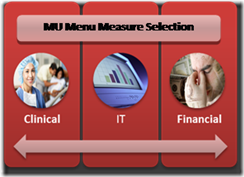Meaningful Use Menu Measure Selection is a Strategic Financial Opportunity
By Matt Wimberley
Santa Rosa Consulting
It’s common knowledge that meaningful use should be viewed as more than just an IT initiative; impacts from participation in the EHR Incentive Program are felt across hospital operations – from clinical to IT to financial. Nevertheless, with IT serving as the ostensible driver of the program, it’s easy for a hospital’s financial leadership to step aside, pushing most of the strategic decision making to IT and clinical departments, simply following up to make sure that meaningful use attestation was completed and that the incentive check will indeed be coming. This is a mistake. Meaningful Use is an opportunity to improve a hospital’s financial outlook beyond incentive payments, particularly in the face of some of CMS’s fast approaching pay-for-performance reimbursement programs.
One quickly approaching reimbursement program is the Hospital Readmission Reduction Program (HRRP). Tucked away in the Patient Protection and Affordable Care Act, the HRRP aims to reduce readmissions by reducing reimbursement for hospitals that are deemed to have “excess readmissions” related to Medicare inpatient heart failure, heart attack, and pneumonia discharges. Hospitals’ reimbursement will be reduced an increasing percentage for each discharge deemed excess by CMS’s readmission methodology, with a reduction percentage cap of 1% of total Medicare reimbursement in 2013, 2% in 2014, and 3% in 2015 and beyond. In 2015, however, the number of discharges deemed excess by CMS’s methodology will likely increase for most hospitals when the Secretary of the HHS follows a statutory directive to increase the number of applicable conditions included in the program from the initial 3 conditions to 7.
Participation in meaningful use menu measure selection offers an opportunity for a hospital’s financial leadership to have a say in reducing, or even removing, these readmission penalties from the bottom line. For example, Stage 1 meaningful use attestation requires a hospital to select 5 out of a list of 10 measures. Of course, not each of the 10 measures is equally suited to reducing hospital readmissions. Five of the measures – the recording of advanced directives, incorporation of structured lab data, and the capability to submit immunization, syndromic surveillance, and lab data to public health agencies – do little or nothing to combat excess hospital readmissions. On the other hand, 5 of the measures – drug formulary checking, generation of listings of patients for quality improvement, providing patients with education, reconciling medications, and summary of care records at transitions – can be utilized as part of a comprehensive hospital initiative to not only reduce excess readmissions, but also to improve patient care.[1]
As one can see, at a minimum, it’s imperative that hospitals’ financial leadership take an active seat at the table in the discussion of any MU menu measure selection. If your hospital has already selected its menu measures and attested to Stage 1 meaningful use compliance, now is the time to review those selections and prepare for Stage 2 measure selection to ensure the decisions made give your organization the proper forward momentum to maximize financial success in the changing reimbursement landscape.
[1] See Boutwell, A. Hwu, S. Effective Interventions to Reduce Rehospitalizations: A Survey of the Published Evidence. Cambridge, MA: Institute for Healthcare Improvement; 2009.
Matt Wimberley is a consultant and blogger at Santa Rosa Consulting where this article post was first published. Santa Rosa Consulting is a national provider of management consulting and information technology services to the healthcare industry.

